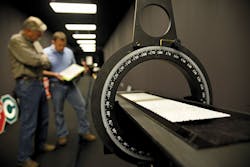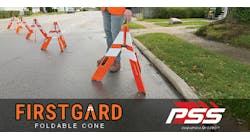Longitudinal pavement markings include edge lines, centerlines and lane lines on multilane roadways. While pavement markings have been in use for more than 100 years now and their inherent value generally goes unchallenged, there are still key unknowns when trying to quantify the benefits of pavement markings.
Recent research findings from the Texas A&M Transportation Institute (TTI) are providing new discoveries to help quantify the value of pavement markings and enhance the value they can provide.
In 2012, TTI released a study providing the most compelling evidence yet that wider edge lines on rural two-lane highways are a cost-effective, statistically sound approach to reducing crashes and fatalities. As one of the authors of this study, I was able to conclude that “[t]his is the first formal evidence of a correlation between wider edge lines and improved crash safety. Previous studies were light on data, were naïve in analysis techniques, and lacked data to provide statistically significant results.”
Studies show a minimum safety-derived threshold value for road-markings maintenance.
In the past, many states adopted wider edge lines (6 in. wide instead of the default width of 4 in.) for various reasons, but adoption has been slow and uncoordinated, and has lacked sound empirical findings to support the decision. The recent analysis looks at data from a Federal Highway Administration (FHWA) study, which included crash and other data from three states—Kansas, Michigan and Illinois—that respectively implemented wide edge lines in different ways. The analysis of the data from these early adopter states provides the largest dataset available to date to study and determine the benefits of wide edge lines on rural two-lane highways.
Crash reduction
The study demonstrated that wide edge lines can reduce total crashes 15% to 30%, and fatal-plus-injury crashes 15% to 38%. In addition, the benefit-cost ratio for wider edge lines is $33 to $55 for each $1 spent. These findings offer a data-supported alternative for shoulder rumble strips in areas where roadside development may lead to potential noise concerns caused by the rumble strips.
While the increased width of pavement markings provides both daytime and nighttime benefits, crash statistics show that nighttime travel is inherently less safe than daytime travel; the nighttime fatality rate is about three times higher than the daytime fatality rate. Longitudinal pavement markings are designed to be retroreflective so that they reflect light back toward nighttime drivers, which makes the markings brighter than they would be otherwise, as in the lines in most parking lots where paint is used alone. The addition of retroreflective properties on highways is meant to increase the value of pavement markings and help mitigate the hazards of driving at night.
Adding retroreflective properties to pavement markings is usually accomplished with small spheres of recycled glass, but other, more advanced retroreflective optics also are available. These advanced retroreflective optics, which generally cost more, also provide more retroreflectivity and therefore brighter nighttime markings. While it is true that cost is relative to quality in such cases, the dilemma has been how much retroreflectivity is needed to have an effect on nighttime safety. While retroreflectivity can be quantified, it is generally in a continuous and unpredictable stage of deterioration, which makes it difficult to know the pavement-marking retroreflectivity value associated with specific nighttime crashes.
As I’ve noted in the course of TTI’s research on this subject, it’s a hard thing to measure. For one thing, in order to gather accurate data for safety analyses, you would have to know the level of brightness or retroreflectivity a pavement marking had at the time someone ran off the roadway.
As it turns out, we had a nearly perfect opportunity to study this issue using data from the Michigan Department of Transportation (MDOT). MDOT has been measuring the retroreflectivity of its pavement markings on an annual basis longer than any other state in the country. The amount of data from MDOT provided the first chance to thoroughly evaluate the effectiveness of retroreflective pavement markings on nighttime crashes.
Compelling evidence
With FHWA support, TTI gathered Michigan crash data and retroreflectivity measurements from 2002 through 2008. Researchers compared the retroreflectivity measurements with certain types of crashes such as single-vehicle, nighttime crashes that occurred during dry conditions and non-snow months.
The research evidence was compelling. It demonstrated that maintenance of pavement-marking retroreflectivity can have a positive effect on safety, and also provided a statistical association between pavement-marking retroreflectivity and nighttime safety showing that brighter pavement markings can lead to safer roadways.
The effect of the retroreflectivity of the yellow centerlines on nighttime crashes and single-vehicle nighttime crashes with low retroreflectivity (≤150 mcd/m2/lx) was found to be statistically significant. The results suggest that expected crash frequency decreases as the centerline retroreflectivity increases, specifically in the low range (≤150 mcd/m2/lx). A follow-up study using the same MDOT data but with innovative analysis techniques was able to establish a safety-derived minimum threshold value for the maintenance of centerline markings on rural two-lane highways of 175 mcd/m2/lx.
The research team also estimated crash modification factors for the range of retroreflectivity values in the Michigan dataset. This evaluation quantified how sites with the brightest pavement markings (i.e., sites with large sums of retroreflectivity values) are characterized by fewer crashes. Conversely, the evaluation found that sites with lower retroreflectivity values are characterized by up to 35% more crashes.
Another leader in the measurement of pavement-marking retroreflectivity is the North Carolina Department of Transportation (NCDOT). Using eight years of NCDOT retroreflectivity and crash data, the research team expanded the MDOT analysis to provide tools to consider various scenarios of the expected safety benefit associated with the retroreflectivity of pavement markings. Table 1 outlines the potential safety benefits of maintaining the retroreflectivity of pavement markings, as such practice is expected to associate with fewer crashes on two-lane rural highways.
Below left: An example of retroreflective stripe marking.
Below right: TTI has been conducting tests to establish pavement-marking criteria for automated vehicles.
Bright future
For the past 100 years, pavement markings have been designed and applied to help drivers of vehicles see the alignment of the roadway and maintain their lane position. Over that time, pavement markings have evolved significantly. For example, their color has been standardized, their width has been set, warranting criteria have been established to define when they should be used, retroreflective properties have been added, contrast has been provided to add daytime visibility for markings on concrete pavements, and, more recently, wet-retroreflectivity properties have been used more often to provide brighter markings at night in rainy and wet conditions. The next evolution for pavement markings is already under way—pavement markings have a key role in the successful deployment of automated vehicles.
Automated vehicles’s lane-departure warning and lane-keeping assistance systems rely on the ability of cameras in the vehicle to see and read the pavement markings around it. TTI is already working on research focused on enhancing pavement markings to support these advanced vehicle technology deployment.
Researchers are using TTI’s Visibility Research Laboratory to test the performance of various camera-based systems in detecting existing and prototype pavement markings. The testing includes low-visibility conditions simulating heavy rains, thick fog and low sunlight, which cause high glare. Additionally, researchers are investigating new sensing technologies to further enhance pavement-marking detection. Promising technologies will be evaluated at high speeds on a closed-course test track.
TTI also is working to develop pavement-marking criteria for automated vehicles. Using traditional pavement-marking quantification techniques, as well as new analysis efforts, TTI is working with a team of vehicle industry experts and pavement-marking industry experts to develop a methodology and criteria that can be used by highway agencies to build and maintain certified roads or certified lanes for automated vehicles. The goal of this work is to develop a functional specification for pavement-marking criteria that supports advanced vehicle technologies and accelerates their potential safety benefits. ST



